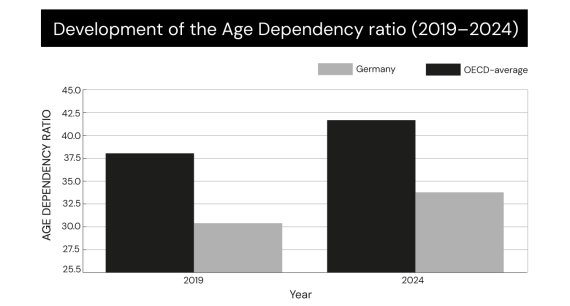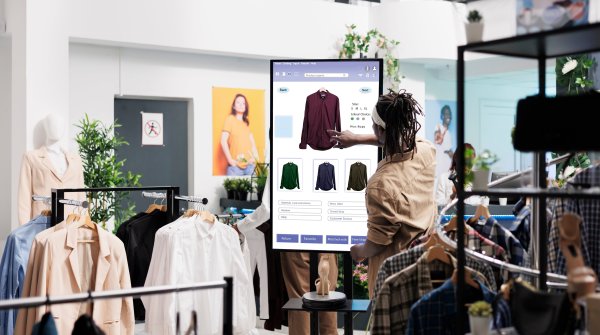Demographic and technological change are two of the most significant drivers of change in many business models - and the retail sector is no exception. Sports retailers and manufacturers of sporting goods are also feeling this pressure. At the heart of the matter is how retailers can continue to assert themselves and generate growth in the face of increasing pressure on purchasing power.
The ageing society makes it clear that it is becoming increasingly urgent to redistribute income in order to support pension funds and healthcare systems. This development will put further pressure on consumers' purchasing power in the coming years. To illustrate the dynamics of this change: The old-age dependency ratio - i.e. the number of people over 65 per 100 people of working age - is rising rapidly. According to the OECD, this figure rose in Germany from 38.0 in 2019 to 41.7 in 2024. The average for OECD countries rose from 30.2 to 33.9 in the same period. There is no end in sight to this trend.

In a society where disposable incomes are under severe pressure due to ageing and consumers are increasingly weighing up what they spend their money on, the sale of non-essential items has no long-term growth potential. To escape this threat of stagnation or even shrinkage, retailers must take the step towards the next generation of retail - towards Retail 5.0, a data-driven ecosystem of products and services.
For retailers, the advantage of such ecosystems lies in new sales potential, improved customer loyalty, reduced willingness to switch and a higher customer lifetime value. In addition, more comprehensive customer data offers deeper insights into customers' habits and needs. This enables a more precise and relevant approach and paves the way for new sales opportunities through retail media. For suppliers, this opens up stable partnerships with retailers, increased visibility among customers, the opportunity for targeted brand campaigns and thus increased brand loyalty and sales growth.
The modern retail ecosystem, also known as Retail 5.0, is made possible by technological advances. In China, the leading retail platforms have been demonstrating for years the direction in which retail will also develop here in the medium term: Alibaba, JD.com and Pinduoduo as established players, Temu and Shein as dynamic newcomers. They all have one thing in common: a deep understanding of their customers and the ability to make the best possible use of their data.
Since the pandemic, consumer attitudes towards data collection have changed significantly. For most consumers today, sharing data is acceptable as long as they get a clear benefit from it and the use of data remains transparent. Younger generations in particular, the digital natives, are already extremely open to data-based business models - and the next generation Alpha, the first AI natives, will surpass this openness. Retail customers will increasingly experience the benefits through individualized offers, improved service and app-based loyalty systems.
Technological progress in recent years has enabled a quantum leap in the individualization of experiences. Improved computing capacities on smartphones and faster mobile networks such as 5G and soon 6G are generating an unprecedented amount of data. An estimated 90 percent of the data that has ever existed has been generated in the last two years alone.
On the processing side, for example, the rapid introduction of artificial intelligence (AI) into everyday business life since the end of 2022 has opened up completely new possibilities. By using artificial neural networks (ANN) and deep learning, the vast amounts of data can be structured and valuable insights and strategic options can be filtered out.
Retailers - including sports retailers - need to prepare for these developments. It is crucial to get to grips with the latest technologies now in order to lay the foundations for future business models. These models will shape areas such as assortment expansion, demand forecasting, supply chain optimization, omnichannel strategies, marketing and customer loyalty.
Specialty retailers must use the new technological possibilities tobecome even more relevantfor their customersthrough product ranges and services and to secure long-term loyalty. In the face of competition from the major internet platforms, a deep understanding of customer needs and trends is needed, combined with expert service and unique experiences - both online and in-store.
The major trends that will be decisive for important customer segments in the coming years include
- SustainabilityEnvironmentally friendly products are a must for more and more consumers. Sports brands and retailers should increasingly focus on sustainable materials and production methods to minimize their environmental footprint.
- Climate adaptability: Climate change poses new challenges for sport. In future, materials and designs will have to withstand extreme weather conditions such as heat waves or heavy rain.
- Personalization: The demand for personalized products, be it tailor-made sportswear or individual equipment, will continue to rise. Technologies such as 3D printing and digital customization options will play a role here.
- Health and wellness focus: The trend towards a healthier lifestyle will continue. Sports retailers could increasingly offer products that promote fitness, wellness and mental health.
- Technology integration: Wearable technologies and smart sports devices that collect data on performance and health are becoming increasingly popular. Retailers can offer training on how to use these technologies alongside these products.
- Omnichannel strategies: The merging of online and offline sales channels will continue to be important. Customers expect a seamless shopping experience, whether they shop in-store or online.
- E-sports and gaming: The e-sports sector is growing rapidly and sports retailers should consider offering products and accessories for gamers to attract this target group.
- Community building: Retailers should focus more on building communities by organizing events, workshops or training groups.
- Experiential retail: Physical stores could focus more on the customer experience by offering interactive elements, test areas and events that enrich the shopping experience. Customer data should be used to personalize experiences and offers.
- Diversity and inclusion: Brands and retailers will increasingly look to offer a diverse product range that appeals to different body shapes, genders and ethnic backgrounds. Sportswear for Muslim women has recently stood out as a particularly dynamic segment.
Digitalization has long since permeated all areas of life and is also significantlychanging the mindset of consumers. Daily smartphone use - around 3.5 hours on average - and the rise of fast social media such as TikTok and Instagram have significantly shortened concentration and attention spans. This has a direct impact on how retailersshould communicate with their customer segments.
The use of AI-based programs enables a more individualized approach. The industry is still a long way from true individualization and consumers are still treated as part of a group of similar consumers. However, these groups are being defined more and more specifically, which will significantly increase the relevance of the approach. Retailers need to stay on the cutting edge of technology to combine with their expertise to provide a customer experience that sets them apart from the big online platforms.
Customers also expect ever faster innovation cycles. This is already a reality in the sporting goods industry, especially with the digitalization of design, dyeing and distribution processes. The speed at which new ideas and trends reach the shelves of specialist retailers will continue to increase. In the foreseeable future, the question of whether production in Asia can still meet the demands for innovation speed will therefore also become relevant - a ship typically takes four to six weeks to transport goods from China to Europe. In view of the possibility of shortening design processes to just a few days, it could make strategic sense to relocate parts of production closer to the European core markets.
The future of retail will be shaped by a multitude of social and technological changes that require a comprehensive adaptation and strategic realignment of business models. Retailers that proactively shape these developments and adapt flexibly to the needs of their customers will come out on top in an increasingly competitive environment.
This adjustment is not easy for everyone, but with a little help, for example from the Zukunftsinstitut, the transition in this changing environment can be mastered.

 Sports BusinessDisruptive marketing - changing the outdoor industry
Sports BusinessDisruptive marketing - changing the outdoor industry
- Awards
- Mountain sports
- Bike
- Fitness
- Health
- ISPO Munich
- Running
- Brands
- Sustainability
- Olympia
- OutDoor
- Promotion
- Sports Business
- Textrends
- Triathlon
- Water sports
- Winter sports
- eSports
- SportsTech
- OutDoor by ISPO
- Heroes
- Transformation
- Sport Fashion
- Urban Culture
- Challenges of a CEO
- Trade fairs
- Sports
- Find the Balance
- Product reviews
- Newsletter exclusive area
- Magazine






